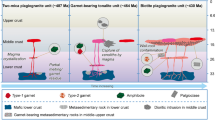Abstract.
Volcán Huaynaputina is a group of four vents located at 16°36'S, 70°51'W in southern Peru that produced one of the largest eruptions of historical times when ~11 km3 of magma was erupted during the period 19 February to 6 March 1600. The main eruptive vents are located at 4200 m within an erosion-modified amphitheater of a significantly older stratovolcano. The eruption proceeded in three stages. Stage I was an ~20-h sustained plinian eruption on 19–20 February that produced an extensive dacite pumice fall deposit (magma volume ~2.6 km3). Throughout medial–distal and distal parts of the dispersal area, a fine-grained plinian ashfall unit overlies the pumice fall deposit. This very widespread ash (magma volume ~6.2 km3) has been recognized in Antarctic ice cores. A short period of quiescence allowed local erosion of the uppermost stage-I deposits and was followed by renewed but intermittent explosive activity between 22 and 26 February (stage II). This activity resulted in intercalated pyroclastic flow and pumice fall deposits (~1 km3). The flow deposits are valley confined, whereas associated co-ignimbrite ash fall is found overlying the plinian ash deposit. Following another period of quiescence, vulcanian-type explosions of stage III commenced on 28 February and produced crudely bedded ash, lapilli, and bombs of dense dacite (~1 km3). Activity ceased on 6 March. Compositions erupted are predominantly high-K dacites with a phenocryst assemblage of plagioclase>hornblende>biotite>Fe–Ti oxides±apatite. Major elements are broadly similar in all three stages, but there are a few important differences. Stage-I pumice has less evolved glass compositions (~73% SiO2), lower crystal contents (17–20%), lower density (1.0–1.3 g/cm3), and phase equilibria suggest higher temperature and volatile contents. Stage-II and stage-III juvenile clasts have more evolved glass (~76% SiO2) compositions, higher crystal contents (25–35%), higher densities (up to 2.2 g/cm3), and lower temperature and volatile contents. All juvenile clasts show mineralogical evidence for thermal disequilibrium. Inflections on a plot of log thickness vs area1/2 for the fall deposits suggest that the pumice fall and the plinian ash fall were dispersed under different conditions and may have been derived from different parts of the eruption column system. The ash appears to have been dispersed mainly from the uppermost parts of the umbrella cloud by upper-level winds, whereas the pumice fall may have been derived from the lower parts of the umbrella cloud and vertical part of the eruption column and transported by a lower-altitude wind field. Thickness half distances and clast half distances for the pumice fall deposit suggests a column neutral buoyancy height of 24–32 km and a total column height of 34–46 km. The estimated mass discharge rate for the ~20-h-long stage-I eruption is 2.4×108 kg/s and the volumetric discharge rate is ~3.6×105 m3/s. The pumice fall deposit has a dispersal index (Hildreth and Drake 1992) of 4.4, and its index of fragmentation is at least 89%, reflecting the dominant volume of fines produced. Of the 11 km3 total volume of dacite magma erupted in 1600, approximately 85% was evacuated during stage 1. The three main vents range in size from ~70 to ~400 m. Alignment of these vents and a late-stage dyke parallel to the NNW–SSE trend defined by older volcanics suggest that the eruption initiated along a fissure that developed along pre-existing weaknesses. During stage I this fissure evolved into a large flared vent, vent 2, with a diameter of approximately 400 m. This vent was active throughout stage II, at the end of which a dome was emplaced within it. During stage III this dome was eviscerated forming the youngest vent in the group, vent 3. A minor extra-amphitheater vent was produced during the final event of the eruptive sequence. Recharge may have induced magma to rise away from a deep zone of magma generation and storage. Subsequently, vesiculation in the rising magma batch, possibly enhanced by interaction with an ancient hydrothermal system, triggered and fueled the sustained Plinian eruption of stage I. A lower volatile content in the stage-II and stage-III magma led to transitional column behavior and pyroclastic flow generation in stage II. Continued magma uprise led to emplacement of a dome which was subsequently destroyed during stage III. No caldera collapse occurred because no shallow magma chamber developed beneath this volcano.
Similar content being viewed by others
Author information
Authors and Affiliations
Additional information
Electronic Publication
Rights and permissions
About this article
Cite this article
Adams, N.K., de Silva, S.L., Self, S. et al. The physical volcanology of the 1600 eruption of Huaynaputina, southern Peru. Bull Volcanol 62, 493–518 (2001). https://doi.org/10.1007/s004450000105
Received:
Accepted:
Issue Date:
DOI: https://doi.org/10.1007/s004450000105




